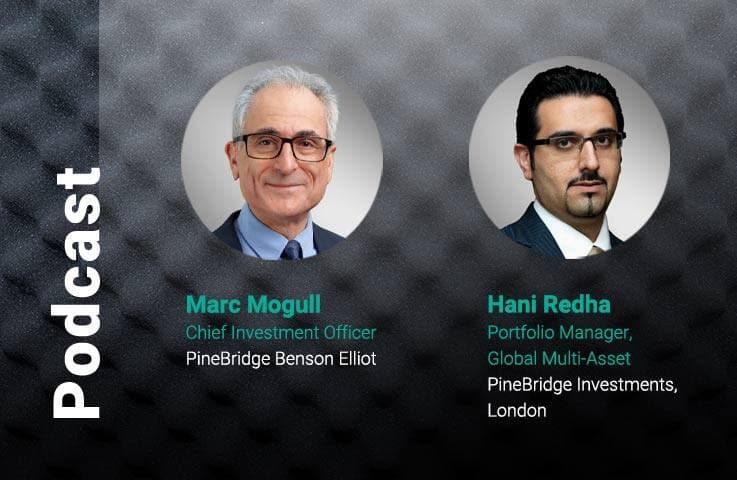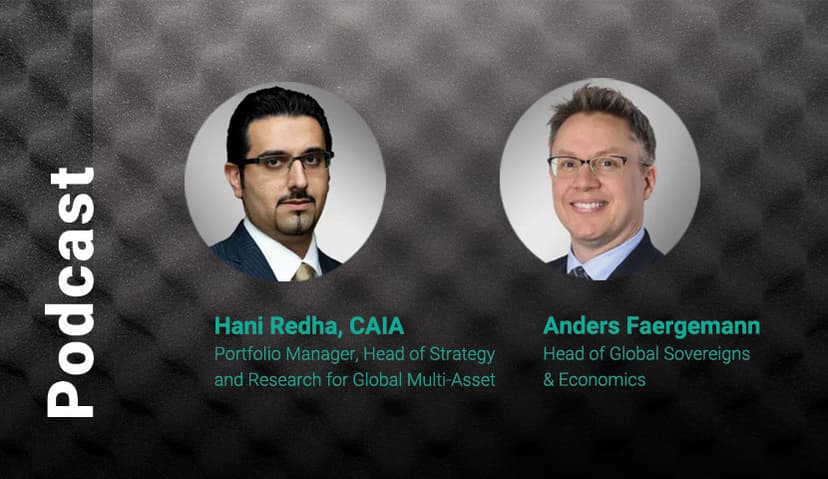Capital Market Line: The Political Pendulum Swings Forward

Michael J. Kelly, CFA
Global Head of Multi-Asset

Hani Redha, CAIA
Portfolio Manager, Head of Strategy and Research for Global Multi-Asset

Steven Lin, CFA
Portfolio Manager, Global Multi-Asset

Peter Hu, CFA, FRM
Portfolio Manager, Global Multi-Asset

Sunny Ng, CFA
Portfolio Manager, Global Multi-Asset

Mikhail Johaadien
Research Analyst, Global Multi-Asset

Teresa Wang
Vice President, Research Analyst, Global Multi-Asset

Political pendulum swings can transpire over multiple timeframes, with the largest changes occurring on the scale of decades. After 10 years of “Stall Speed” growth following the global financial crisis, prolonged by a balance sheet recession during which private consumption and investment were slow and confidence languished as private sector balance sheets were rebuilt, governments amplified this slowness by running austere fiscal programs. They did so while tightening regulation over the banks to an extent that made lending difficult, further reinforcing the slow period. Central banks experimented with ever more forceful instruments, and with the private sector intent on deleveraging and banks shoehorned into building capital instead of lending, these central bank balance sheet surges bypassed the economy and ended up stimulating capital markets instead, thereby amplifying inequality.
With time, growing confidence and emerging populist fiscal policies began to chip away at austerity. When Covid arrived, a second deluge of macro policies did as well. Yet this time both fiscal and monetary policy were taken to extremes. Markets benefited more than the masses from these policies, with populism festering on the right and the left. Looking over our five-year Capital Market Line (CML) horizon, on the fiscal side of the ledger, populist reflationary policies look poised to gain ground, almost irrespective of which way the election goes – though more so under a Trump presidency. On the monetary side, after a painful wave of inflation, policies are expected to persist in their attempt to rein in the monetary excesses they put in place after the global financial crisis and the Covid pandemic.
Fiscal loosening is gaining ground, particularly in developed markets (DMs). Europe’s growth and stability pact, long held together by pledges to cap fiscal deficits at 3%, may be tested by the likely political gridlock in France. While previously the nation was expected to dial back spending to cut its current 5.5% fiscal deficit, that no longer looks realistic. And if one of the eurozone’s two core constituents ignores the pact, what does that mean for the others?
The US presidential election will be the next key test of the strength of populism, and its impact on fiscal policies. Both parties will further restrict trade, with Biden restricting exports of technology and Trump extending and broadening tariffs on imports. Both will retain a good portion of the 2017 Tax Cuts and Jobs Act’s $5 trillion of individual tax cuts (note that Biden would make permanent the expiring tax cuts on individuals making less than $400,000, while Trump would make permanent all expiring individual tax cuts). Biden trade and tax impacts would be mildly reflationary, and Trump’s would run hot. On immigration, regulation, and industrial policy, their policies are diametrically opposed. During Trump’s first term, “run hot” policies were helpful during that slow growth period with excess slack. Today, with no slack left, Trump’s run-even-hotter policies look friendly to stocks and the US dollar but appear risky to the bond market. His supply-side policies (on regulation) might offset the reflationary impact of his tax, tariff, and immigration policies over time, although we’d expect the US rates curve to steepen first.
Developed market central bank balance sheets surged after the financial crisis and then again in the wake of Covid, having never retrenched appreciably in the interim. As inflation followed, DM central banks had to raise the price of money, but its availability did not shrink to an equivalent degree thanks to the banks’ use of numerous new tools. DM central banks now face the long slog of right-sizing the availability of funds and reconnecting it with price, or risk perpetually overshooting their inflation goals. This process will extend well beyond our five-year CML horizon. Despite this, for cyclical reasons, we have just begun a global easing cycle. We expect far fewer policy rate cuts over this entire easing cycle than the market, for reasons including the lingering need to right-size today’s overly ample reserves and liquidity, but also precedent: Though policy rate-cutting cycles have, on average, resulted in several hundred basis points of cuts, cuts have been much lower during soft landings. While inflation and real interest rates look poised to come down a bit from current levels, they will likely remain higher over the next five years than during the post-crisis period.
On the micro side, irrespective of the election, we might see disinflationary trends reminiscent of the late 1990s, a period characterized by more confident investment and capital deepening over time. This helped nurture a surge in productivity and a rise in the Internet. Today, we have the rapid ascent of artificial intelligence (AI), along with more vibrant investment, gradual capital deepening, and improving productivity following a 15-year slump.
Meanwhile, during the Xi era in China, security objectives, national rejuvenation, and “common prosperity” have increasingly taken precedence over economic metrics. We see no change in this trend coming out of the nation’s Third Plenum. The CCP, and not the markets, will play an ever more decisive role. Government investment and advancement of select industries are every country’s prerogative but are market-distorting, and many other countries may begin to erect offsets to China’s export of these distortions. China will likely respond by continuing to fortify and build trade bridges to the Global South, enticing them to transact in the yuan – a securityrelated trade policy that requires a steady yuan. Related policies involve keeping interest rates from dropping as much as they’d need to keep the economy from slowing further.
Private investment, consumption, and growth inside China have been slower under this new Xi era regime. Coming out of the Third Plenum, we see a step-up in consumption taxes on luxury goods to replace part of the lost tax revenue from prior land sales for local governments, along with more rental income from local governments, and state-owned enterprises owning more social housing. The new luxury-oriented consumption taxes are consistent with China’s common prosperity objectives, yet will hit European luxury goods quite hard – another step toward slow but steady global decoupling. The economic frictions from ever-weaker trade linkages imply an enduring source of structural inflation. Populism in the democracies also suggests higher inflation and real interest rates over the coming cycle than post-crisis averages, even if they trend a bit lower than at present.
Western companies are investing heavily to relocate their supply chains. Along with climate and national defense concerns and the ballooning need for electricity to power AI, investment demands will continue to outstrip the inclination to save – a tendency that keeps easing despite high cash rates. Notwithstanding the imminent global easing cycle, we don’t see positive real interest rates and inflation shrinking all the way back to post-crisis norms. Equities, which don’t flourish under positive real rates, at least have offsets in the form of faster growth, spurred on by a more vibrant investment backdrop.
Our CML remains flatter than we would like, driven in large part by ongoing policy distortions, yet these are simultaneously sustaining and creating dispersion opportunities. AI is likely to come on much faster than the Internet did, amplifying these effects. Taken together, these trends point toward being more selective about which markets, sectors, and currencies one diversifies into over the next five years – investors must take pains not to “diworsify.”
Capital Market Line as of 30 June 2024 (Local Currency)

Capital Market Line as of 30 June 2024 (USD View, Unhedged)

Please see Capital Market Line Endnotes. Note that the CML’s shape and positioning were determined based on the larger categories and do not reflect the subset categories of select asset classes, which are shown relative to other asset classes only.
Insights From Today’s CML
A flatter Capital Market Line (CML) with greater dispersion. The current flatness of our CML stems primarily from the policy-related distortions noted above, but also from higher real yields boosting expected fixed income returns after strong equity price appreciation. With the tapering of quantitative tightening (QT) now intended to last longer and go further, today’s overly ample liquidity will gradually normalize. The full extent of this likely runs beyond our five-year time horizon. There is no empirical evidence that risk premia are constants that are added to real rates. We see some equity risk premia declining from here. However, the significant variation around the CML indicates that the current environment still presents opportunities for high-active-share investing, focusing on strengthening growth arising from technological and geopolitical changes.
Equities outperform in soft landings. With inflation and growth now inflecting down, a global easing cycle is emerging. When central banks stay ahead of growth downshifts, soft landings unfold. We expect both. Meanwhile, though consumers are showing fatigue from overspending their savings as well as income, consumer price inflation is now disinflating faster than consumer incomes, rebooting sustainable consumption. Such trends should foster selective broadening of the markets. Promising areas include Asia-Pacific exporters, where the goods manufacturing recession seems to have ended. UK equity is very inexpensive post-Brexit and sensitive to interest rate cuts, benefiting from positive immigration trends. Markets favor moderate policies, and the new center-left Labour policies could positively surprise markets. While Asian manufacturers of consumer goods and UK equities look poised to benefit most from rate cuts, our mainstay equity allocations remain our Productivity and US Quality baskets. Rapid AI advancements and still-tight labor markets will support rising technology budgets. In the interim, with a unit growth and pricing downshift unfolding, sticking with quality still seems timely.
Credit spreads will likely remain tight. In the current “Balanced Growth” regime, the correlation between stocks and bonds has become muted, unlike in “Stall Speed” regimes, which exhibit strongly negative correlations, particularly during stressed conditions. This lessens the allure of risk-free fixed income. Although we view credit spreads as tight versus post-crisis norms in most areas, we believe this is justified in the more vibrant period expected through most of the next five years. Exceptions can be found in Asia’s high yield market, excluding China property, and mortgage-backed securities (MBS), which offer more normal spreads.
A focus on diversifying risk-free curves. We observe a “cooling off” trend in the US economy and inflation, although with run-hot policies coming. Despite the imminent policy rate-cutting cycle, soft landings have resulted in far fewer rate cuts than recessions. With run-hot policies on the way, we see the US Treasury curve heading for a better environment, yet not a banner one, as if the soft landing segued into something harder. Meanwhile, Europe’s prospects look less vibrant, and its yield curves appear more attractive than for US Treasuries. This differential could widen significantly in a Trump victory, although US dollar-based investors would need to hedge back to dollars.
Gold is viewed as a safe-haven asset amid rising geopolitical risks. In times of uncertainty and global turmoil, gold stands out as a potential safe haven. China’s push for de-dollarization in the Global South by shifting reserves from US Treasuries to gold, along with the People’s Bank of China’s efforts to stabilize the yuan, strengthen gold’s appeal. Additionally, the potential for global disruptions is increasing due to China’s pivot toward state-led investment, Russia’s ambitions to reclaim Soviet-era borders, and Iran’s enhanced power projection through drone technology. These factors escalate tensions, currently contained to proxy conflicts. As support for globalization weakens and nationalism rises, gold is seen as a strategic hedge against geopolitical risks, further supported by de-dollarization efforts.
The Fundamentals Driving Our CML
More populism, more fiscal oomph, more volatility. Political polarization and cultural shifts have pushed fiscal policy toward increased government spending. This looser fiscal stance, combined with more vibrant investment relative to savings, requires more restrictive monetary policy. The previous era was marked by the aftermath of a balance sheet recession, where fiscal austerity and extremely loose financial conditions prevailed due to an overreliance on monetary policy. In contrast, the new regime features healthier household and corporate balance sheets, leading to more robust consumption and investment. Although real yields are likely to see some relief, they are expected to remain well above the levels seen in the 15 years following the global financial crisis.
From a demand shortfall to supply-driven growth. After the financial crisis, a period of consumer-led deleveraging led to reduced consumption of goods, followed by lower investment and productivity. Over time, consumer balance sheets improved and savings increased. The pandemic marked a turning point, triggering a surge in demand for goods and services fueled by unprecedented monetary and fiscal stimulus – effectively a manifestation of Modern Monetary Theory. This, combined with massive Covid-related supply chain disruptions, caused a temporary spike in inflation. Since then, global bottlenecks in goods have largely been resolved, and the US labor force has experienced an immigration-driven supply shock coupled with productivity improvements. These factors have contributed to robust economic growth since 2023, which is also disinflationary. We believe we are moving toward a medium-term regime characterized by balanced growth, although geopolitical risks remain a significant threat to global economic stability.
AI enhances productivity. Advances in technology, combined with higher investments and improved worker skill sets, are reshaping labor trends. Breakthroughs like ChatGPT are transforming the tech sector, boosting labor efficiency, creating new jobs, and increasing productivity. AI automation, especially generative AI, is expected to affect up to two-thirds of current jobs by automating about a quarter of tasks. This transformation could greatly enhance US labor productivity, redefine work, and drive innovation and efficiency across industries. Additionally, AI can streamline operations, reduce costs, and improve decision-making, making it a critical driver of future economic growth.
China’s decoupling from developed markets may restrict supply growth. Geopolitical tensions are leading Western firms to relocate their supply chains from China to regions closer to their consumer base or with more aligned political views, such as the US, Mexico, India, and Vietnam. Although emerging markets offer lower labor costs, overall expenses may surpass those in China. In a deglobalizing world, securing supply chains incurs higher costs, resulting in substantial investments and reduced efficiency. These forces are adding to sticky inflation in the medium term while spurring investment in the interim.
The energy transition drives growth while reducing savings. The energy crisis spurred by the Russia/Ukraine conflict has accelerated the shift toward green energy. This has led to initiatives like the US Inflation Reduction Act (IRA) and the EU’s Green Deal Industrial Plan, aimed at boosting lowcarbon energy investments. The increase in decarbonization and defense spending is expected to stimulate economic growth and maintain structural tightness in certain product markets. However, it will also reduce the global savings surplus. Combined with tight monetary policies by central banks, this will restrict the supply and demand for funds, creating a medium-term trend of less generous capitalization rates.
ESG 2.0. We see a growing trend toward ESG practices more prevalent outside the eurozone. This approach, which we call “ESG 2.0,” focuses on assessing and engaging with companies to incentivize improvement in ESG metrics, rather than denying capital to all those with poor ESG standings. This method encourages sectors that are traditionally ESG laggards to enhance their practices, offering the benefit of a lower cost of capital in exchange for better ESG practices. High-emission industries, now generating significant cash flow, are moving toward greener operations, which is essential for addressing the $2.9 trillion funding gap needed to achieve net-zero emissions. ESG 2.0’s “carrot and stick” approach represents a significant shift from the “just say no” tactic of ESG 1.0, which focused predominantly on the current status of a company or industry, denying capital to many that needed to invest for new, more ESG-efficient processes.
Capital Market Line Endnotes
The Capital Market Line (CML) is based on PineBridge Investments’ estimates of forward-looking five-year returns and standard deviation. It is not intended to represent the return prospects of any PineBridge products, only the attractiveness of asset class indexes, compared across the capital markets. The CML quantifies several key fundamental judgments made by the Global Multi-Asset Team for each asset class, which, when combined with current pricing, results in our annualized return forecasts for each class over the next five years. The expected return for each asset class, together with our view of the risk for each asset class as defined by volatility, forms our CML. Certain statements contained herein may constitute “projections,” “forecasts,” and other “forward-looking statements” which do not reflect actual results and are based primarily upon applying a set of assumptions to certain financial information. Any opinions, projections, forecasts, and forward-looking statements presented herein are valid only as of the date of this document and are subject to change. There can be no assurance that the expected returns will be achieved over any particular time horizon. Any views represent the opinion of the investment manager and are subject to change. For illustrative purposes only. We are not soliciting or recommending any action based on this material.
About the Capital Market Line
The Capital Market Line (CML) is a tool developed and maintained by the Global Multi-Asset Team. It has served as the team’s key decision support tool in the management of our multi-asset products. In recent years, it has also been introduced to provide a common language for discussion across asset classes as part of our Investment Strategy Insights meeting. It is not intended to represent the return prospects of any PineBridge products, only the attractiveness of asset class indexes compared across the capital markets.
The CML quantifies several key fundamental judgments made by the Global Multi-Asset Team after dialogue with the specialists across the asset classes. We believe that top-down judgments regarding the fundamentals will be the largest determinants of returns over time driving the CML construction. While top-down judgments are the responsibility of the Multi-Asset Team, these judgments are influenced by the interactions and debates with our bottom-up asset class specialists, thus benefiting from PineBridge’s multi-asset class, multi-geographic platform. The models themselves are intentionally simple to focus attention and facilitate a transparent and inclusive debate on the key drivers for each asset class. These discussions result in 19 interviews focused on determining five year forecasts for over 100 fundamental metrics. When modelled and combined with current pricing, this results in our annualized expected return forecast for each asset class over the next five years. The expected return for each asset class, together with our view of forward-looking risk for each asset class as defined by volatility, forms our CML.
The slope of the CML indicates the risk/return profile of the capital markets based on how the five-year view is currently priced. In most instances, the CML slopes upward and to the right, indicating a positive expected relationship between return and risk. However, our CML has, at times, become inverted (as it did in 2007), sloping downward from the upper left to the lower right, indicating risk-seeking capital markets that were not adequately compensating investors for risk. We believe that the asset classes that lie near the line are close to fair value. Asset classes well above the line are deemed attractive (over an intermediate-term perspective) and those well below the line are deemed unattractive.
We have been utilizing this approach for over a decade and have learned that, if our judgments are reasonably accurate, asset classes will converge most of the way toward fair value in much sooner than five years. Usually, most of this convergence happens over one to three years. This matches up well with our preferred intermediate-term perspective in making multi-asset decisions.
Disclosure
Investing involves risk, including possible loss of principal. The information presented herein is for illustrative purposes only and should not be considered reflective of any particular security, strategy, or investment product. It represents a general assessment of the markets at a specific time and is not a guarantee of future performance results or market movement. This material does not constitute investment, financial, legal, tax, or other advice; investment research or a product of any research department; an offer to sell, or the solicitation of an offer to purchase any security or interest in a fund; or a recommendation for any investment product or strategy. PineBridge Investments is not soliciting or recommending any action based on information in this document. Any opinions, projections, or forward-looking statements expressed herein are solely those of the author, may differ from the views or opinions expressed by other areas of PineBridge Investments, and are only for general informational purposes as of the date indicated. Views may be based on third-party data that has not been independently verified. PineBridge Investments does not approve of or endorse any republication of this material. You are solely responsible for deciding whether any investment product or strategy is appropriate for you based upon your investment goals, financial situation and tolerance for risk.




